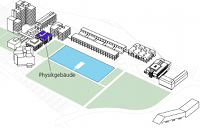Position Indication:
Content

2009 - Thomas Winkler
Ga1-xMnxP synthesized by ion implantation and pulsed-laser melting
Diplomarbeitsprojekt:
Aufenthalt an der University of California, Berkely, USA
1.09.2009 – 31.01.2010
Thomas WINKLER
Contact: vorname(/\t)nachname.net
Final Report:
still missing!
Proposal:
Spin-dependent phenomena and their applications in e.g. the combination of non-volatile storage and processing of data on a single chip have been prompting the research in diluted magnetic semiconductors (DMSs) over the past decade. Despite a massive progress in the controlled fabrication of these materials systems, the understanding and control of DMS have emerged as the most controversial and challenging field of today’s material science and condensed matter physics. In order to achieve the expected outstanding functionalities, it is mandatory to gain a complete mastering over the physical and chemical properties of the materials systems under investigation and to correlate their fabrication parameters to their structural properties and carrier-mediated magnetic behaviour, possibly at a practical room temperature (RT) [1].

Fig. 1 Dependence of TC on the magnetic ion concentration and density of hole states at the Fermi level for a weak and a strong coupling.
Currently, one of the most studied DMS, namely (Ga,Mn)As shows ferromagnetic signatures up to 180 K, a temperature far from the expected and wanted RT. The reason of the low Curie temperature (TC) is a matter of active investigation by many excellent groups world-wide. One explanation is related to the fact that – especially in the strong coupling regime (small lattice constant like in e.g. ZnO and GaN) – the binding energy of magnetic impurities is enhanced or there is the onset of Zhang-Rice-like bound states even if there is no Coulomb potential associated with the magnetic ion. This shifts the metal-insulator transition (MIT) to higher hole concentrations, as shown in Fig. 1. It has been predicted [2] but not yet verified experimentally, that once MIT is reached, so that bound states are washed out by many body screening, holes are again free to mediate the exchange interaction between magnetic ions and high values of TC will re-enter, as predicted within the virtual crystal approximation (VCA). The main goal of the proposed project is to shed new light into the relation between ferromagnetism in DMSs and carriers, by fabricating (Ga,Mn)P samples with a high concentration of carriers and by subsequently testing the feasibility of manipulating at RT magnetisation direction in the samples simply by applying an electric field, as demonstrated (but only at low temperatures) in the case of (Ga,Mn)As [3]. The proposed material system is in a coupling regime stronger than (Ga,Mn)As, therefore it is expected – once the MIT is crossed – to have a considerably high TC.
In order to proof this assumption, in the frame of the proposed project, I will prepare (Ga,Mn)P samples at the host Institution in Berkeley by ion implantation and pulsed-laser melting (II-PLM). II-PLM is an established technique for achieving extremely high doping concentrations in semiconductors and Prof. O. Dubon in Berkeley is the recognised world expert in this experimental procedure [4].
The activity to be performed in Berkeley is strongly related to the research carried out by the group of A. Bonanni at the Institute for Semiconductor and Solid State Physics of the Johannes Kepler University in Linz. Here nitride-based (strong coupling) DMS are fabricated and comprehensively characterised. My stay at Berkley is expected not only to be extremely profitable for his personal curriculum and to represent the basis of his Master thesis, but also to remarkably shed new light onto a very controversial and timely topic and to critically strengthen the relation between Berkeley and Linz.
Once back in Linz, I will test the feasibility of the field-induced magnetisation switching. A thorough characterisation of the structures by means of high-resolution transmission electron microscopy and synchrotron radiation x-ray diffraction is also foreseen.
[1] A. Bonanni et al. Phys. Rev. Lett. 101, 135502 (2008).
[2] T. Dietl, Phys. Rev. B 77, 085208 (2008).
[3] D. Chiba et al. Nature 455, 515 (2008).
[4] M.A. Scarpulla et al. Phys. Rev. Lett. 95, 207204 (2005).


 Audit hochschule und familie
Audit hochschule und familie

